How to create a minimalist interior design
Architect Shrawan Azagalle | 18 April 2023

Creating a minimalist interior design is about achieving a simple, yet stylish look with a few key elements. The idea behind this style is to reduce clutter and emphasize clean lines and natural textures. Minimalist design typically incorporates a neutral color palette, such as white, black, and grey, and uses natural materials like wood, stone, and metal. This style often relies on functional and practical furniture pieces that serve a purpose while also being aesthetically pleasing. Lighting also plays an important role in minimalist design, with natural light and strategically placed light fixtures being used to highlight key features of the space. Overall, a minimalist interior design creates a peaceful and serene atmosphere while also being functional and visually appealing.
Wall
When it comes to minimalist interior design, walls are an important element that should be kept simple and clean.
White or neutral colored paint is a popular choice for minimalist walls, as it creates a sense of space and lightness. Other materials that can be used to create a minimalist wall design include concrete, exposed brick, and natural wood paneling.
For example, a minimalist living room with white walls could feature a concrete accent wall with simple clean lines that adds a touch of texture and visual interest to the space. In a bedroom, natural wood paneling on one wall can create a warm and inviting atmosphere, while still maintaining the clean lines and simplicity of minimalist design. Exposed brick can also be used to add a touch of industrial style to a minimalist space, as seen in loft-style apartments.
Overall, the choice of wall material in a minimalist interior design depends on the desired aesthetic and the overall feel of the space. However, the key is to keep the design simple and clean, with a focus on natural textures and neutral colors.
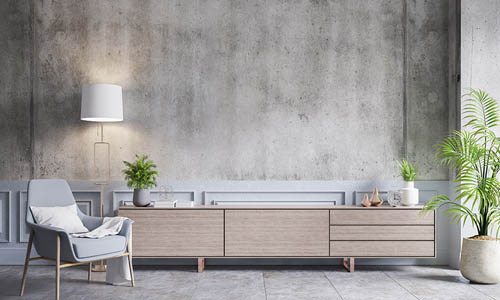
Flooring
In minimalist interior design, flooring is an essential component that helps to tie the entire space together. The choice of flooring material should be functional, practical, and visually appealing, with a focus on natural textures and neutral colors.
Polished concrete is a popular choice for minimalist flooring due to its clean lines and industrial look. It's a durable and low-maintenance option that can be used in a variety of spaces, from living rooms to kitchens and bathrooms. For example, a minimalist kitchen with polished concrete floors can create a sleek and modern look that is both functional and stylish.
Natural wood flooring is another popular choice for minimalist interiors, with light-colored woods like oak and maple being particularly popular. Wood flooring adds warmth and texture to a space, while still maintaining the simplicity and clean lines of minimalist design. For example, a minimalist bedroom with light-colored wood floors and white walls can create a peaceful and serene atmosphere.
Bamboo is also a sustainable and eco-friendly flooring option that works well in minimalist interiors. It has a natural look and feel, with a subtle texture that adds visual interest to a space. Stone tiles are another option for minimalist flooring, with their natural textures and colors adding a touch of elegance to any room. For example, stone tiles in a minimalist bathroom can create a spa-like atmosphere, with a focus on clean lines and simplicity.
Overall, the choice of flooring material in a minimalist interior design depends on the desired aesthetic and the overall feel of the space. However, the key is to keep the design simple and clean, with a focus on natural textures and neutral colors.
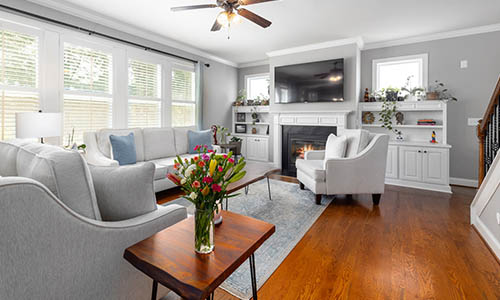
Furniture
Furniture is a crucial element in minimalist interior design, with a focus on clean-lined and functional pieces made of natural materials such as wood, leather, or metal. The idea behind minimalist furniture is to have a purposeful design that is aesthetically pleasing, without any unnecessary embellishments.
For example, a simple wooden bed frame with clean lines and minimal detailing can be a perfect fit for a minimalist bedroom. A metal and glass coffee table with clean lines can create a modern look for a minimalist living room, while a leather sofa can add warmth and texture to the space.
Minimalist furniture also typically emphasizes functionality and practicality. For example, a wooden dining table with a simple design and clean lines can serve as a functional centerpiece for a minimalist dining room, while a metal and leather desk can create a functional workspace in a minimalist home office.
In addition, minimalist furniture often incorporates natural materials such as wood, leather, or metal, which help to create a warm and inviting atmosphere. These materials are also sustainable and eco-friendly, which is an important consideration in modern interior design.
Overall, the key to choosing minimalist furniture is to keep the design simple, functional, and aesthetically pleasing, while incorporating natural materials whenever possible.
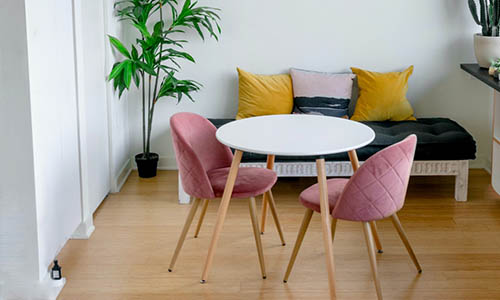
Lighting
Lighting is an essential aspect of minimalist interior design that plays a crucial role in setting the tone and mood of a space. The lighting should be simple and functional, with a focus on creating a well-lit space that is both aesthetically pleasing and practical.
Simple light fixtures that blend in with the space are a hallmark of minimalist design. Recessed lighting is a popular option that can provide a clean and modern look without taking up any visual space. Pendant lights with a simple design can also be used to provide focused light in specific areas, such as over a dining table or kitchen island.
Natural light is also an important consideration in minimalist interior design, as it can create a sense of spaciousness and openness. Large windows or skylights can be used to bring in natural light and highlight key features of the space, such as a natural wood ceiling or a stone accent wall.
For example, a minimalist living room with large windows can create a bright and airy atmosphere, with natural light highlighting the clean lines and simple design of the furniture. In a bedroom, recessed lighting can create a calm and relaxing ambiance, while a pendant light above the bed can provide focused light for reading.
Overall, the key to minimalist lighting is to keep it simple and functional, with a focus on creating a well-lit space that is both aesthetically pleasing and practical. Whether utilizing natural light or artificial light fixtures, the lighting should blend in with the space and enhance the minimalist aesthetic.
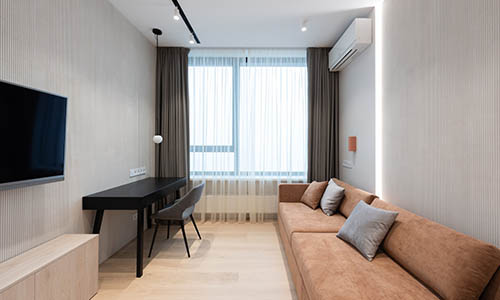
Decor
Decor is an important aspect of minimalist interior design, but it is typically limited to a few key pieces that serve as focal points of the space. These pieces should be simple, functional, and aesthetically pleasing, without any unnecessary embellishments.
A piece of art or a sculpture made from natural materials like wood or stone can be a great addition to a minimalist space, adding visual interest without overwhelming the space. For example, a simple wooden sculpture on a side table or a stone vase on a mantle can create a focal point in a minimalist living room.
Plants and greenery can also be used as decor in minimalist interior design, adding a touch of nature to the space. A single potted plant or a small collection of succulents can add color and texture to a minimalist bedroom, while a tall indoor tree can create a dramatic statement in a minimalist living room.
Overall, the key to minimalist decor is to keep it simple and understated, with a focus on functionality and natural materials. By choosing a few key pieces that complement the space and enhance the minimalist aesthetic, you can create a peaceful and serene atmosphere that is both functional and visually appealing.
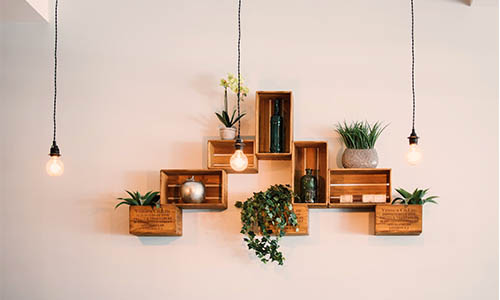
Textiles
Textiles can play an important role in minimalist interior design, adding texture and warmth to the space without overwhelming the clean lines and simple aesthetic. When choosing textiles for a minimalist space, it is important to stick to simple and neutral colors, such as white, black, grey, and beige.
A white linen duvet cover can add a soft and airy feel to a minimalist bedroom, while a black and white striped rug can provide visual interest without disrupting the overall simplicity of the space. A cream-colored throw blanket can also be a great addition, adding warmth and texture to a minimalist living room without introducing any unnecessary clutter.
When selecting textiles for a minimalist space, it is important to choose high-quality materials that are both durable and aesthetically pleasing. Natural materials like linen, cotton, and wool are great options that can add texture and depth to the space.
For example, a minimalist bedroom with a simple wooden bed frame can be elevated with the addition of a white linen duvet cover and a few neutral-colored accent pillows. In a living room, a black and white striped rug can create a graphic statement when paired with a leather sofa and a few simple metal accent tables.
Overall, the key to minimalist textiles is to keep it simple and understated, with a focus on texture and natural materials. By choosing simple and neutral-colored textiles that complement the space, you can add warmth and comfort to a minimalist interior design without detracting from its overall aesthetic.
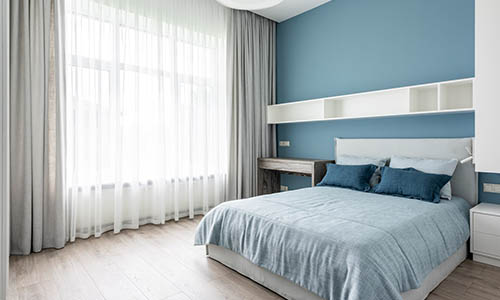
A minimalist interior design is all about simplicity and functionality, with a focus on clean lines, natural materials, and a neutral color palette. When designing a minimalist space,
it is important to choose high-quality materials and functional furniture pieces that serve a purpose while also being aesthetically pleasing.
Lighting and decor should be simple and understated, with a few key pieces like art or plants adding a touch of visual interest.
Simple and neutral-colored textiles can also add texture and warmth to the space without overwhelming the minimalist aesthetic. By following these key principles,
a minimalist interior design can create a peaceful and serene atmosphere while also being visually appealing and functional.
As an architect, I find that designing minimalist interiors allows me to truly appreciate the beauty of clean lines and understated elegance.
I believe that simplicity can be just as powerful as complexity, and a well-designed minimalist space can evoke a sense of calm and serenity that is unmatched by more ornate designs.
I love the challenge of creating functional and beautiful spaces using only the most essential elements, and I believe that a minimalist approach can bring a sense of harmony and balance to any environment.